#1796 Pattern Light Cavalry Sword
Text


Dutch m1813 No.1 light cavalry troopers sabre.
While initially supplied with English made 1796 Pattern light cavalry sabres in the late months of 1813, the Dutch Army procured a further 3,800 sabres from different Solingen manufacturers between 1814 and 1819.
The m1813 No. had a long service life, being issued to the Light Dragoons, Hussars, Lancers and the East Indian Cavalry. Even when it was replaced in 1829 with the No.3 light cavalry sabre, many were re-issued to the 'Jagers te Paard' and second line units.
They likely remained in service until the late 1830s early '40s when the remaining stocks were inspected and put into storage at the Artillery depot in Brielle. In 1880 hundreds of out of service swords were transferred to the Rijksmuseum and put on display in the Waterloo hall.
While there are visual differences between the Prussian m1811 Blucher sabre, itself a copy of the 1796 Pattern, the Solingen produced m1813 No.1's are visually identical to British made sabres, and can only be identified by their Dutch control stamps and the absence of British ones.
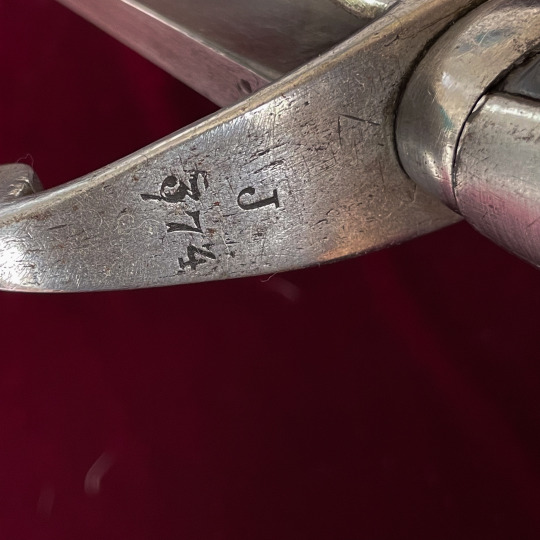

This sabre was one of the swords re-issued to the Jagers te Paard (hunters on horse) as can be seen by the serial number on the quillon which appears to have over-stamped an earlier mark. The blade is dated 1833 on the ricasso and the spine has an *L inspectors stamp, probably belonging to P. Libert who, from 1831 was the controller edged weapons, until retirement in 1840.
This 1833 date likely means that the sabre was given a replacement blade supplied by an arms maker from Liege.


The Crown over V stamp belonged to A van Deventer, who was seconded in Solingen 1837-1839 then stationed at the Inspection HQ in Delft 1843-1845
The Crown over JP stamp is believed to have belonged to the Controller Jean Joseph.
The last two photos show the m1813 No.1 next to a 1796 Pattern LC made by Thomas Gill between 1796 and 1800. The Gill sword was likely a private contract for a Yeomanry troop since there are no ordnance board proof stamps on the blade.
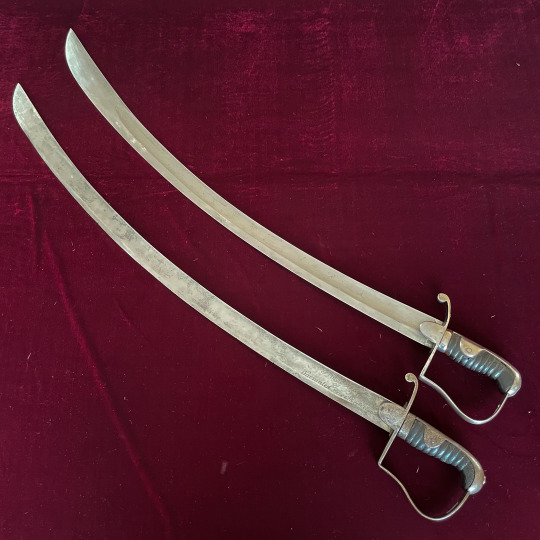

The tip of the m1813 No.1 is noticeably broader than the 1796 Pattern LC. This results in the sword having a 21 cm point of balance vs 16.5 cm on the 1796.
If you look closely at the edge of the 1796, you can see that it is slightly concave. This is evidence of damage in service that has been repaired. The chips that are also visible and commonly seen on other blades are more likely to have been caused by careless owners after they were sold out of service.
#Dutch Army#Cavalry#Light cavalry#m1813 No.1 Sabre#Sword#Sabre#Antique#Military Antiques#napoleonic wars#10 Day War#1796 Pattern Light Cavalry Sword
62 notes
·
View notes
Photo



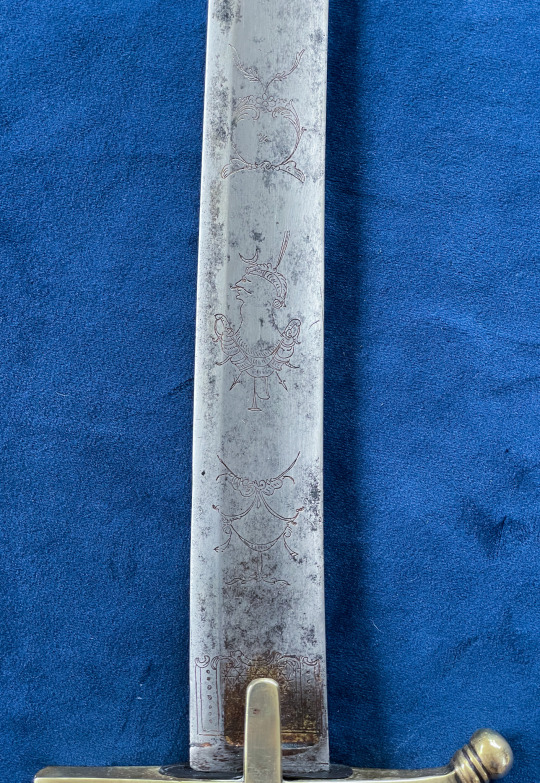
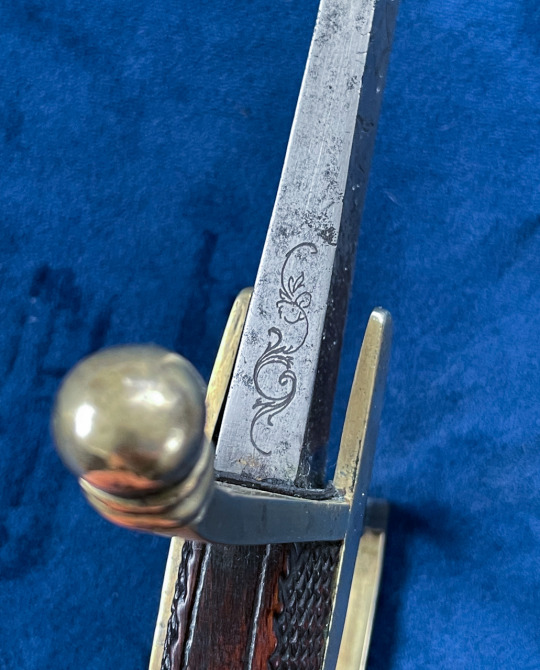
First sword delivery of 2023 has finally arrived. Not my first purchase this year but the first to reach me.
The top sword is a large and heavy French First Empire era cuirassier officers sabre with the ‘Garde de Bataille’ hilt. The blade is is marked with the Solingen Rose on the spine and retains a small amount of etching. Unfortunately it’s missing its’ scabbard and I will try and get a reproduction one made for it.
The second is a French light cavalry officers sabre with the ‘Cote de Melon’ style hilt. This one is likely from the First Republic era. It has a very stout blade that is proportional to one on a troopers’ sabre. Again the blade was made in Solingen and features the typical talismanic engraving typical of the late 18th Century.

A comparison of the French light and heavy cavalry swords to their British contemporaries of the era.
#Swords#Sabres#Antiques#International Arms dealing#Heavy Cavalry#Light Cavalry#cuirassiers#French Army#First Empire#First Republic#Antique weapons#Napoleonic era#Napoleonic wars#Georgian Era#garde de bataille#Cote de melon#1796 Pattern
128 notes
·
View notes
Text




Universal Swords – British 1796 Light Cavalry Saber with Blued and Gilt Blade
This British 1796 Cavalry Saber has been beautifully embellished with a blued and gilt treatment at the base of the blade which was a popular adornment for military officers to dignify their swords above the standard issue to match their rank and station. The tempered blade is forged from 1055 high carbon steel and the hilt is steel with a wood and leather grip. The blade is peened over the pommel to solidly fit the blade into the hilt. The sword is matched with a steel scabbard completed with steel hanging rings.
The British pattern 1796 Cavalry Saber was used by the Hussars, Light Dragoons and Kings German Legion Light Cavalry of the Napoleonic Era. The sword was designed by John Gaspard Le Marchant, one of the finest cavalrymen of his day who bemoaned the long and heavy swords then in use by his expeditionary force during their experience in France during its Revolutionary War. His design became one of the most lauded of cavalry sabers.Unlike its predecessor, the 1796 saber had a more pronounced curve, making slashing easier and deadly. The saber, somewhat unusually among its peers, also widened at its tip, putting weight and heft at the tip making its slashes more vicious.
#Kult of Athena#KultOfAthena#New Item Wednesday#Universal Swords#British 1796 Light Cavalry Saber with Blued and Gilt Blade#British 1796 Light Cavalry Saber#sword#swords#weapon#weapons#blade#blades#European Weapons#European Swords#Early Modern Swords#Early Modern Weapons#18th century
13 notes
·
View notes
Photo

The 1796 Pattern Cavalry Sabre suspension rings for Officer and Trooper variants
The trooper’s rings were also used on some officer’s scabbards, but are rarer then the standard. The trooper’s version was designed to be stronger, and to withstand harsher conditions in mounted and unmounted service. As being governmental owned weapons, they were overly-made. While the officer’s versions tend to fancier and lighter in weight.
#1796#1796 pattern#sabre#georgian#british#napoleonic#napoleonic wars#light cavalry#cavalry#cavalry officer#trooper#antique#antique sword#antique swords#antique sabre
1 note
·
View note
Photo

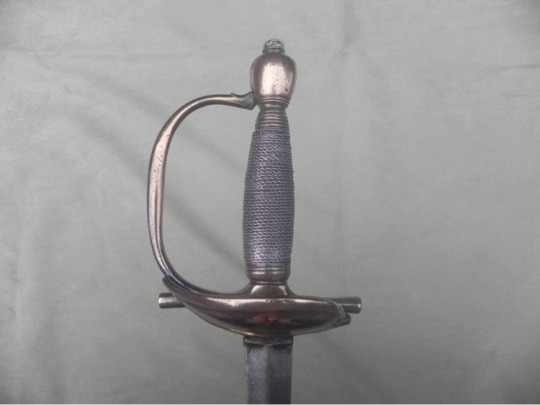
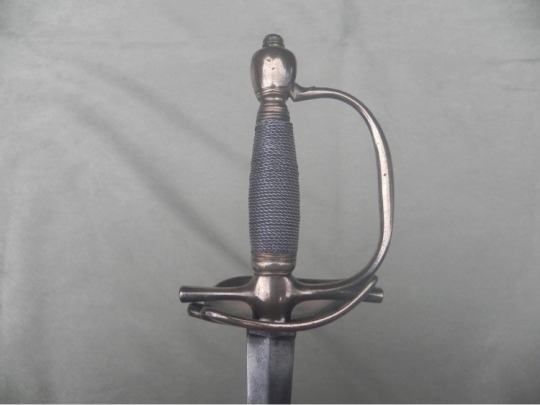
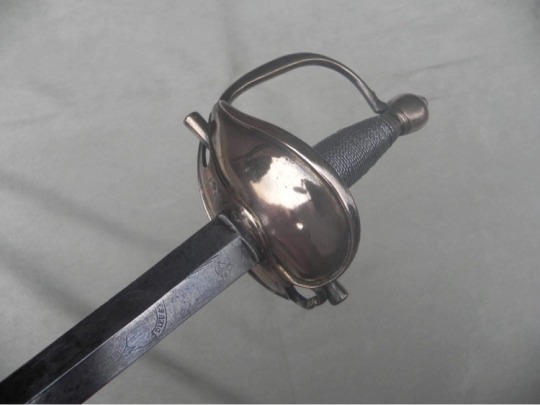
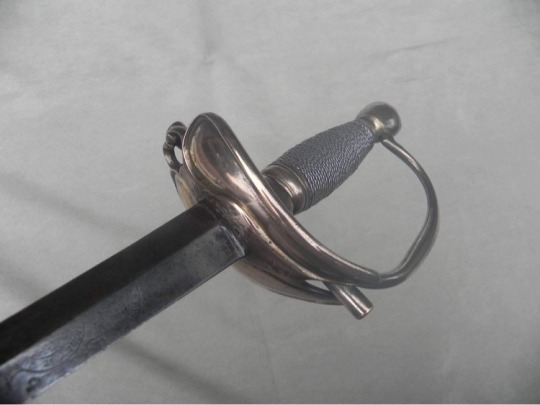



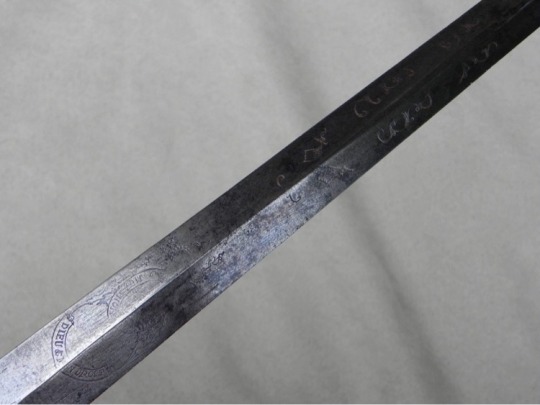
British Officer’s Sword c.1800
This sword is very similar to the Pattern 1796 Heavy Cavalry Officer’s Dress Sword, and it could actually be one. However, I think it might be an infantry officer’s sword, and may pre-date the 1796 regulations. The main departure from most 1796 HC Dress Swords is the manner in which the knucklebow attaches to the pommel. The 1796 HCD’s knucklebow attached with a screw, whereas my example slots into a jolt in the pommel. Additionally, the boat shell guard is asymmetrical.
The blade is of diamond cross-section and has some weight to it--not a light small-sword blade--and is probably a bit better at thrusting than the standard P1796 Infantry Officer’s Sword blade.
It is far from being in top condition, but its unique features have made it an interesting sword to study and own.
Measurements
Weight: 1 lb. 9 1/2 oz.; Blade Length: 31 1/2″; Overall Length: 38 1/4″; PoB: ~3 1/4″
247 notes
·
View notes
Note
What sword do you prefer? I have a 19 century basket hilt, but its rather uncomfortable to use.
My favourite type of sword is an Oakeshott type XIIa or type XVIIIb profile blade. I’m quite fond of longswords and bastard swords in general, being the main type of sword that I use, and a trade off between one and two-handed sword types.
For one handed swords, I prefer type XIIIb.
I’m generally fond of blades with a slight taper profile, that isn’t too extreme, with a fuller, and I’m a sucker for cruciform swords as a whole. I’m fond of straight bar type crossguards, but I also like the curving crescent type blades as well.

When not being overly Eurocentric, I’m fond of Japanese swords in general, especially tachi and uchigatana, Chinese dao pattern swords and jian, Indian Tulwars, Persian Shamshir (I love how elaborate these can be), and African kaskara and shotel (both of which I’ve got some experience in handling).
I’m not a huge fan of baskethilts, though I have studied using them under a Scottish fencer who specialises in them (and has slapped me around before during bouts), though I do appreciate how iconic they are.
I’m also *very* fond of Victorian sabers, though I don’t do much saber outside of messing around, and prefer those closer to the 1796 pattern light cavalry saber, as it closely resembles later Polish szabla, which I also have a fondness for, much like I do for shamshir.
...I like swords in general, to be sure, but out of all of these, as I started saying, I prefer medieval cruciform blades with a slight taper.
28 notes
·
View notes
Link
“Dear friends: It is my great pleasure to announce the release of the new book, “Scottish Fencing: Five 18th Century Texts on the Use of the Small-sword, Broadsword, Spadroon, Cavalry Sword, and Highland Battlefield Tactics.”
Presented by Jared Kirby; Introductions and Historical Essays by Paul Macdonald and Ben Miller
The martial heritage of Scotland and its legendary swordsmen have captured the imagination of readers worldwide for centuries. Likewise, enthusiasts of swordsmanship have cherished classic Scottish fencing treatises by those such as William Hope and Donald McBane. However, up until now, a number of obscure Scottish treatises on the use of the sword have evaded the notice of authors, scholars and researchers. Presented here are five such texts, now published again for the first time in more than two centuries. They include:
I. "Examination & Vindication of the Highlander’s Manner of Attacking and Fighting the Enemy in a Day of Action." — Though not a fencing text, this is an unique early eighteenth century manuscript on battlefield techniques that has never before been published, and is now presented here with the permission of the Royal Library at Windsor Castle. Authored by an anonymous Highland veteran, it includes a spirited defense of the native manner of fighting, and provides new insight into the use of the targe during the period of the great Jacobite conflicts.
II. "The Sword’s-Man; Containing a Series of Observations on the Use of the Sword." — This treatise, authored in 1788 by Edinburgh fencing instructor John Ferdinand, contains instruction in the use of the most popular side-arms of the period: the broadsword, small-sword, and spadroon.
III. "A Dictionary, Explaining the Terms, Guards, and Positions, Used in the Art of the Small Sword." — This useful and interesting glossary on the art of fencing is embedded with numerous instructions, and was written by Hary Fergusson, a native of Aberdeenshire who taught fencing in Edinburgh and North America during the 1760s and 1770s.
IV. "A Treatise on the New Sword Exercise." — This treatise on the use of the cavalry saber was first published in 1797, shortly after the widespread adoption of the 1796 pattern cavalry sword. Its author was Sholto Douglas Sorlie, a native of Edinburgh, Sergeant in the 7th Queen’s Own Light Dragoons, and later a veteran of Salamanca, Vittoria, Pyrennees, Navelle, Orthes, and the Peninsular War.
V. This final chapter explores the life and career of Donald McAlpine, a soldier from Inverness and officer in the famed Queens Rangers (an early Special Operations unit), who taught the use of the back-sword in Boston during the American War of Independence. His student sketched what is currently the earliest known illustration of fencing technique in the American colonies. The full, original page containing the illustration of McAlpine’s instruction is faithfully reproduced herein for the first time ever.
Amazon US link:
https://www.amazon.com/dp/0999056727/
Amazon UK link:
https://www.amazon.co.uk/dp/0999056727/ “
Found here via Irish Swordsmanship: Fencing and Dueling in Eighteenth Century Ireland
42 notes
·
View notes
Photo





1796 pattern light cavalry saber I recently acquired.
Most likely a dress sword as ivory &wire handled with gorgeous bronze stirrup guard and carved scroll work.
The blade is incised and etched and gilted in parts and was originally blued though now faded (it can still be seen in some areas ).
unfortunately there was no scabbard so no makers marks / stamps and believe it or not was salvaged from going in a skip !!!
#1796 pattern saber#1796#saber#sword#antiquesword#napoleonic#napoleonicsword#antiquearms#cavalrysaber#cavalrysword#dresssword#rescued treasure#skiphunter#englishswords#oldsword
46 notes
·
View notes
Text
Top Five Favorite Swords
1: Sidesword
2: 1796 Pattern Light Cavalry Sabre
3: Kaskara
4: Katzbalger
5: Gladius
8 notes
·
View notes
Photo








1803 Flank Officers Sabre
Blade: 85cm
Total: 99cm
These swords were meant to replace the 1796 Infantry straight sword among the fighting regiments of the British Amy. Popular with the |Grenadier, Light Infantry and Rifle officers, in the late 1790s these unofficial infantry sabres started popping up in regiments active on the Continent.
This model, which is essentially a foot version of the widely popular 1796 light cavalry sabre is in good overall condition.
The blade is clean and bright free of any major areas of pitting. The back edge has been ground and sharpened to make this a surprisingly effective thrusting weapon. The blade is solid in the hilt with no movement or rattle.
The hilt is in reasonable condition with some wear to the grip leather. There are elements of the grip wire still attached. And unusually the pommel has been engraved with as simple decorative pattern.
The scabbard is in a good condition with small areas of patina. There are a few minor dents, but they do not detract from the overall appearance.
This is an unusual sword, only having been in service for ten years, and is from a fascinating period of British history that feels very pleasant in the hand.
£350
https://www.facebook.com/pg/Lambert.Lambert.Antiques/photos/?tab=album&album_id=344356616015513
3 notes
·
View notes
Text

What happens when a friend and fellow sword collector comes round to talk swords, collecting, rifles, books and generally chew the fat.
#swords#sabres#spadroons#1796 Pattern#1803 Pattern#French Swords#British Swords#Georgian Swords#Napoleonic Swords#Antiques#Military History#Cavalry#Infantry#Light Cavalry#Heavy Cavalry#Dragoons
487 notes
·
View notes
Text
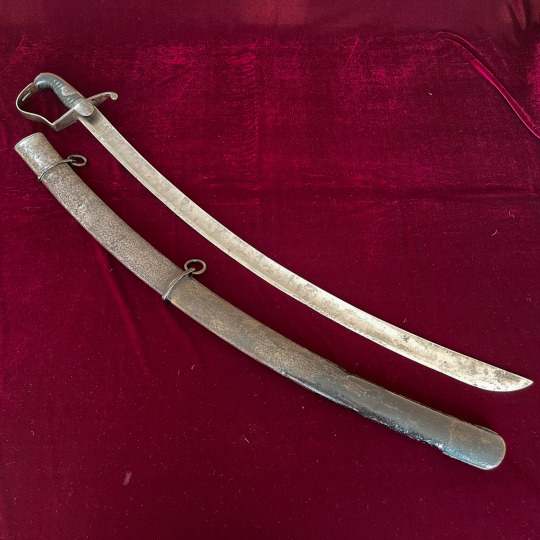


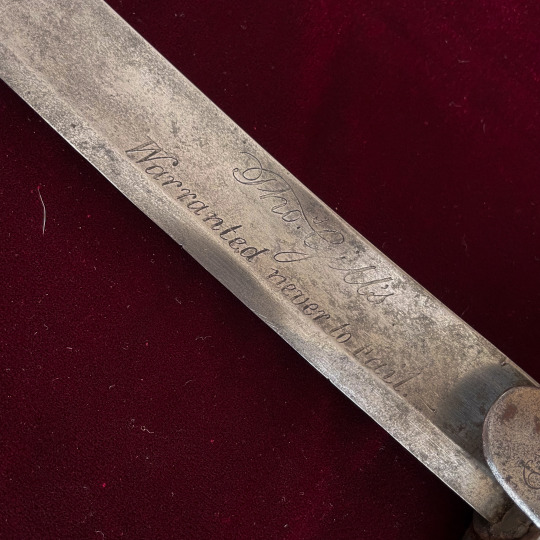

1796 Pattern light cavalry troopers sabre by Thomas Gill, circa 1796 - 1801.
#Sabre#1796 Pattern#1796 Pattern Light Cavalry#British Cavalry#Yeomanry#british army#napoleonic wars#military antiques#swords#antiques#light cavalry#cavalry
113 notes
·
View notes
Text

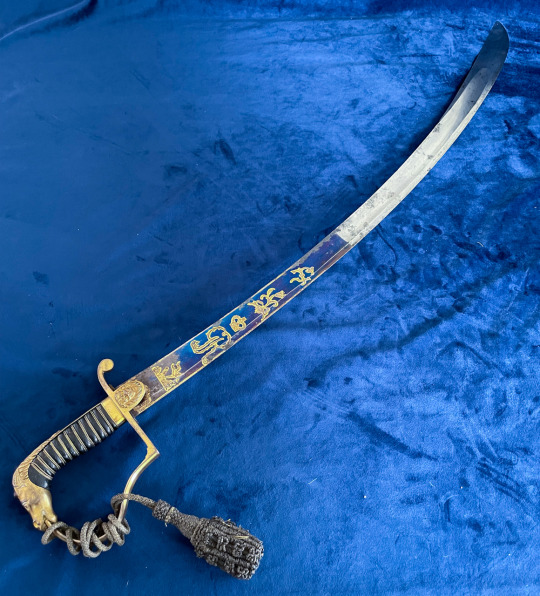
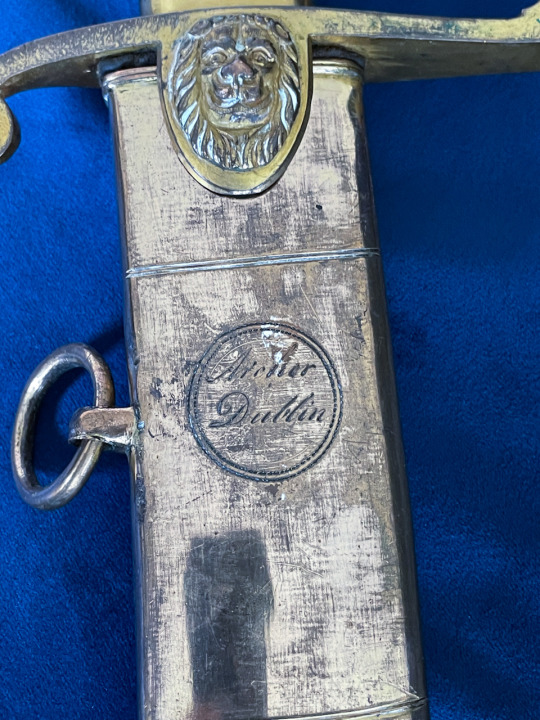
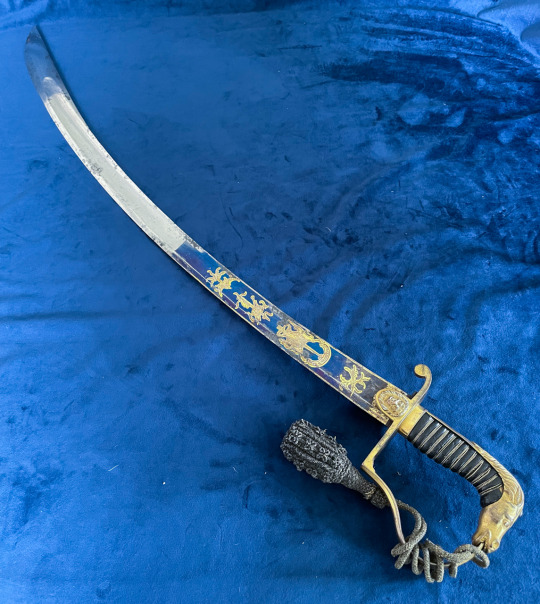
Georgian era Yeomanry officers sabre styled after the 1796 Pattern light cavalry sabre.
Produced by William Henry Archer of Dublin using a Solingen produced blade imported J J Runkel.
This sabre is another example of the many quirky swords that abounded during this period. While the government was working to establish regulation pattern swords, many officers, especially those in the yeomanry, volunteers or militia were content to continue using the equipment that best suited them. As a result there are many surviving examples that are next to impossible to attribute to a unit or branch or service. In only a few examples are we lucky enough to have identifying inscriptions on the sword or scabbard. And even these need to be viewed with caution.
Stylistically, animal motifs were a common decorative feature on swords of this time. With the lions head so popular that it became part of several British Pattern swords, including the sabre still in service with British naval officers. A variation of the animal theme. horse-heads pommels seemed to have been more common among the cutlers from Ireland, with Archer and Reed the more frequently encountered suppliers.
Because the hilt is broadly modeled on the 1796 Pattern light cavalry sabre, with the dual langets, P-shaped stirrup guard and a very functional blade of cavalry proportions, I believe it would have belonged to an Yeomanry officer based in Ireland. The gilt hilt also precludes it from having belonged to a regular army officer.
At the time, the yeomanry had been raised from the upper classes as a reserve force ready to protect Great Britain should Napoleonic France attempt to invade. They also had the secondary function of 'keeping the peace'. In a time before an established police force, the yeomanry were often called upon to break-up any unrest. Which meant that the ones based in Ireland were more active than most.
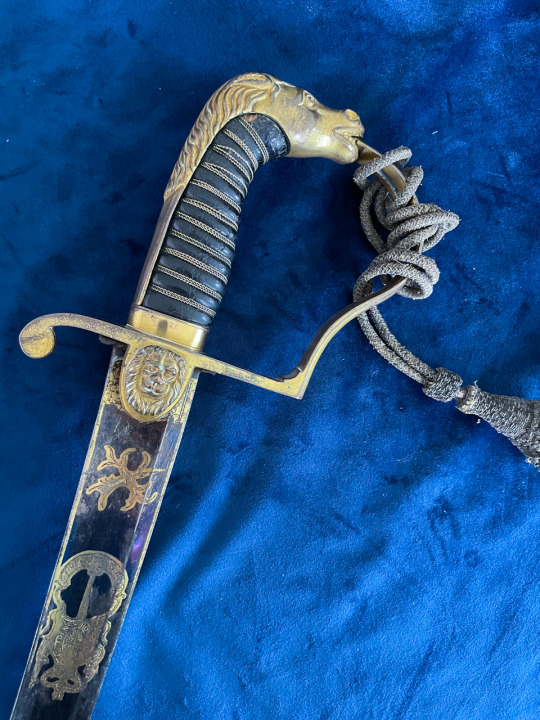
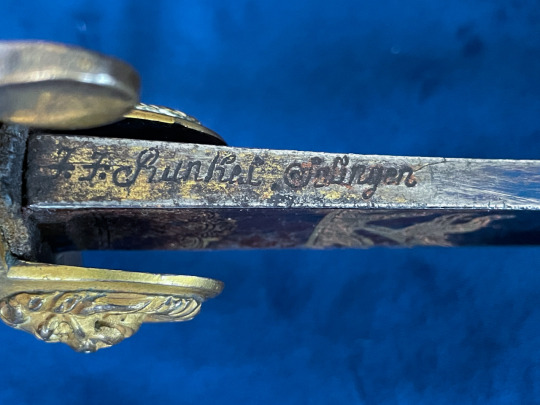
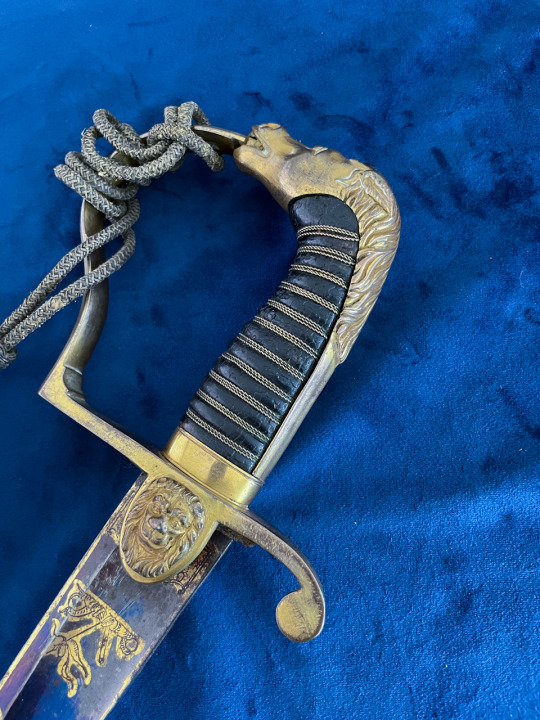
I estimate that this sword dates from 1798 to 1802 based near identical presentation examples produced by William Archer which have inscriptions dated to 1800. The blade is also decorated with the pre-1801 coat of arms so is unlikely to date after 1803.
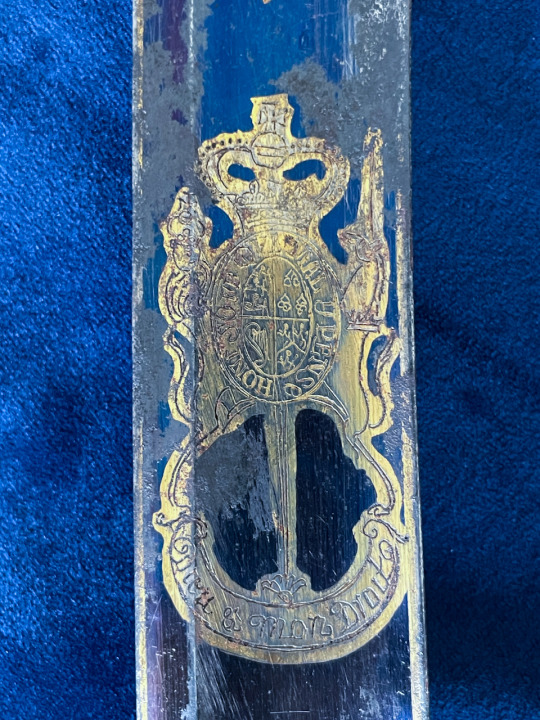
William Henry Archer started his career as a sword cutler in 1783 when he married Margaret Shaw, widow of Richard Shaw.
Richard Shaw, was a sword cutler from 1765 to 1782 when he died of injuries caused by the collapse of Music Hall floor. Margaret continued her husbands business in her name until she married William Archer in 1783. It is quite possible that William was working as an apprentice for the Shaws at the time and the marriage was a way to maintain the business. Such arrangements were not unheard of in a time when women were not allowed to own property or enter into contracts.
Archer continued remained in business until his death in 1830, during this time he also served as Lord Mayor of Dublin in 1812 and 1830 so he must have been a successful and respected businessman of his time.
Stats:
Overall Length - 945 mm
Blade Length - 820 mm
Curve - 55 mm
Point of Balance - 135 mm
Grip Length - 120 mm
Inside Grip Length - 95 mm
Weight - 970 grams
Total Weight - 1,430 grams
#british army#napoleonic wars#cavalry#swords#antiques#light cavalry#sabres#1796 pattern#Yeomanry#British cavalry#19th century#Georgian Era
108 notes
·
View notes
Text


British 1796 Pattern Swords.
A ‘Pattern’ was a centrally held, sealed example that manufacturers could refer to for measurements and other specifications. Because of this, some variation still occurred amongst the different producers. In the British context, Pattern is used in the same way that others use model.
While other patterns already existed for British equipment, such as the Brown Bess musket, the 1796 Pattern was the first introduced for swords, prior, there were the 1786, 1788 and regimental regulation swords. These regulations however, were very broad and now days, get used as much for convenience by collectors than for accuracy.



As the first pattern, the 1796 encompassed all branches of the army, and included:
The infantry sergeants sword
Infantry officers sword
Light cavalry troopers sabre
Light cavalry officers sabre
Heavy cavalry troopers sword
Household Guards troopers sword
Heavy cavalry officers service sword
Heavy cavalry officer dismounted service sword.
In terms of uniformity trooper and sergeant swords were broadly uniform having been purchased and proof tested by the Ordnance Board, another new concept that was introduced at the same time.
However since officers purchased their own swords privately there exists a lot of variation between them. Both in physical specifications such as weight or blade length or even going so far as to change the blade for the new ‘Pipe-back’. Or using a family heirloom blade that was completely non-regulation.
In the photos I show a number of officer and trooper examples, including a light cavalry style hilt on a pipeback blade, a light weight light cavalry style sword with un-fullered shamshir style blade that was likely a cavalry officers dress sword and a heavy cavalry officers dress sword with boatshell guard and a mid 18th century heirloom backsword blade.
#Swords#Sabres#Spadroons#Cavalry#Light Cavalry#Heavy Cavalry#Dragoons#British Army#Military history#Collecting#Antiques#1796 Pattern#1796 Pattern Infantry Officers Sword#1796 Pattern Light Cavalry Sabre#1796 Heavy Cavalry Sword
71 notes
·
View notes
Text
youtube
More video practice. Need to work on speaking more clearly with a bit more volume. Unfortunately the editing software I use won't let me lower the volume of the background clip further.
#antiques#swords#british army#napoleonic wars#military antiques#light cavalry#sabres#1796 pattern#Yeomanry#Youtube
14 notes
·
View notes
Video
youtube
#Swords#sabre#Cavalry#British Army#19th Century#Military history#1796 pattern Light Cavalry Sabre#1854 Pattern Sabre
6 notes
·
View notes